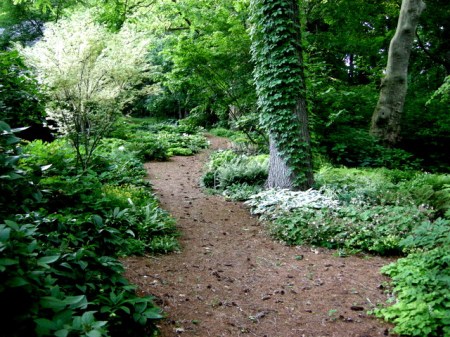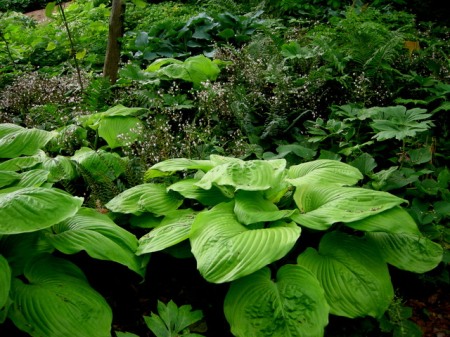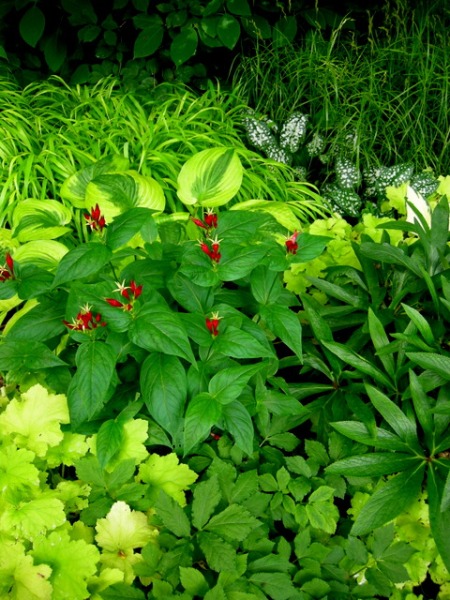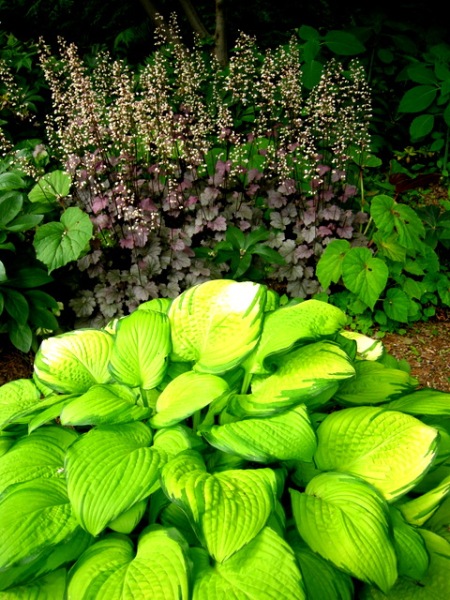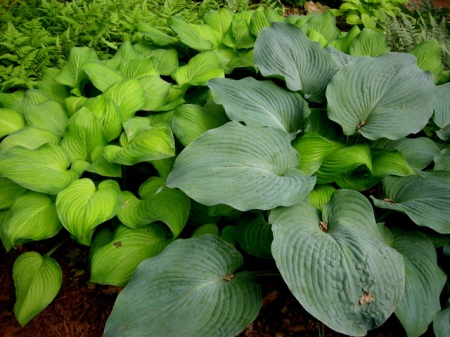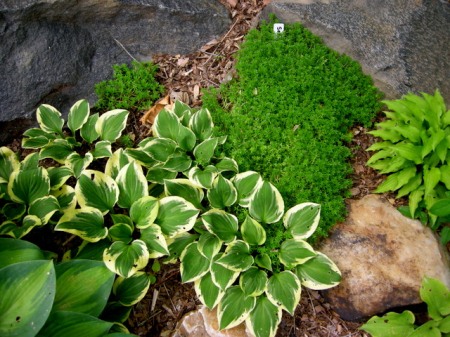 Indian pink or spigelia is the most requested plant at Carolyn’s Shade Gardens. None of our suppliers have any luck growing it in pots, so we are trying to grow it ourselves for sale in 2020.
Indian pink or spigelia is the most requested plant at Carolyn’s Shade Gardens. None of our suppliers have any luck growing it in pots, so we are trying to grow it ourselves for sale in 2020.
A long time ago, Carolyn’s Shade Gardens made sustainable practices one of its missions. We have fulfilled this in many ways, including making a wide range of native plants available to our customers, showcasing native plants in our display gardens, and getting rid of our lawn. Since we purchased the property in 1983, all our gardens have been maintained organically without herbicides, chemical fertilizers, or supplemental water. We mulch with ground leaves, and never use potentially toxic hardwood mulch.
Nursery News: Carolyn’s Shade Gardens is a retail nursery located in Bryn Mawr, PA, specializing in showy, colorful, and unusual plants for shade. The only plants that we ship are snowdrops to US customers only. For catalogues and announcements of events, please send your full name, location, and cell number (for back up use only) to carolyn@carolynsshadegardens.com. Click here to get to the home page of our website for catalogues and information about our nursery and to subscribe to our blog.
 The long spires of black cohosh are one of the highlights of our garden in June.
The long spires of black cohosh are one of the highlights of our garden in June.
You can read more about our sustainable practices and why they are important in these posts:
Your Native Woodland: If You Build it They Will Come, how to create your own woodland filled with native plants
Your Native Woodland: If You Build it They Will Come, Part 2, more native plants for your woodland
My Thanksgiving Oak Forest, the importance of native plants to our survival
Your Most Precious Garden Resource, step-by-step guide to mulching with ground leaves
Letting Go Part 1: The Lawn, the dangers of lawn chemicals to humans, pets, and the environment
Do You Know Where Your Mulch Comes From?, toxic substances in shredded hardwood mulch
Strike a Blow for the Environment in your own Yard, how to incorporate large quantities of native plants into your garden
Looking back over these posts, I realized that many of them feature native plants that bloom in the spring. As 2/3 of the plants in our display gardens are native, I wanted to highlight some of the summer- and fall-blooming varieties. Every photo is taken in our garden, and every plant is native, most to Pennsylvania. If you want to know the Latin name, click on the photo.
.
 We have two gigantic walnuts in our display gardens and have no trouble growing native plants under them. Shown here is oakleaf hydrangea, my favorite of all the hydrangeas, surrounded by blue wood asters, which bloom in October.
We have two gigantic walnuts in our display gardens and have no trouble growing native plants under them. Shown here is oakleaf hydrangea, my favorite of all the hydrangeas, surrounded by blue wood asters, which bloom in October.
.
 My favorite oakleaf hydrangea is ‘Snowflake’ with gorgeous double flowers. Double flowers are not as good for pollinators, so the majority of our oakleafs have single flowers.
My favorite oakleaf hydrangea is ‘Snowflake’ with gorgeous double flowers. Double flowers are not as good for pollinators, so the majority of our oakleafs have single flowers.
.
 Blue wood asters and foamflowers make a weed-free groundcover under our walnuts.
Blue wood asters and foamflowers make a weed-free groundcover under our walnuts.
.
 Coral bells or heucheras add color to the garden all season. However, many of the coral bells marketed to gardeners do not grow well in the mid-Atlantic. At Carolyn’s Shade Gardens we only sell heucheras that thrive in this region, including my favorite ‘Berry Smoothie’.
Coral bells or heucheras add color to the garden all season. However, many of the coral bells marketed to gardeners do not grow well in the mid-Atlantic. At Carolyn’s Shade Gardens we only sell heucheras that thrive in this region, including my favorite ‘Berry Smoothie’.
.
 Our woodland is quiet in summer and fall but blooming along the entrance path is the native shrub, flowering raspberry. I love it for its light green almost tropical leaves and large raspberry-colored flowers.
Our woodland is quiet in summer and fall but blooming along the entrance path is the native shrub, flowering raspberry. I love it for its light green almost tropical leaves and large raspberry-colored flowers.
.
 Maidenhair ferns with their delicate and unusual leaf pattern and wiry black stems are ornamental all season. They spread slowly to make a bigger and bigger patch.
Maidenhair ferns with their delicate and unusual leaf pattern and wiry black stems are ornamental all season. They spread slowly to make a bigger and bigger patch.
.
 Our Ashe magnolia with its gigantic white flowers just finished blooming. At its feet are sweeping stands of culver’s root, which will bloom in late July and August.
Our Ashe magnolia with its gigantic white flowers just finished blooming. At its feet are sweeping stands of culver’s root, which will bloom in late July and August.
.
 White baneberry is just starting to make its creepy fruit, which looks just like its other common name: doll’s eyes. I like everything about this plant—its delicate shrub-like habit, lovely white flowers, and unique berries.
White baneberry is just starting to make its creepy fruit, which looks just like its other common name: doll’s eyes. I like everything about this plant—its delicate shrub-like habit, lovely white flowers, and unique berries.
.
 The yellow and green variegated leaves of ‘Golden Shadows’ pagoda dogwood are beautiful all season, while the spiderwort at its base produces lovely blue flowers now, and the New York ironweed next to it will bloom in August and September.
The yellow and green variegated leaves of ‘Golden Shadows’ pagoda dogwood are beautiful all season, while the spiderwort at its base produces lovely blue flowers now, and the New York ironweed next to it will bloom in August and September.
.
 Giant Solomon’s seal on the right towers over non-native Solomon’s seal to its left. In the foreground is twinleaf, whose elegant and unsual leaves look good all season.
Giant Solomon’s seal on the right towers over non-native Solomon’s seal to its left. In the foreground is twinleaf, whose elegant and unsual leaves look good all season.
. Evergreen hart’s tongue fern (in front) provides interest all year. In the back, our gigantic stand of bottlebrush buckeye is getting ready to put on its breath-taking show.
Evergreen hart’s tongue fern (in front) provides interest all year. In the back, our gigantic stand of bottlebrush buckeye is getting ready to put on its breath-taking show.
.
 We have had no luck with native bleeding-hearts, which we have tried in many different locations in the garden, until it planted itself in the stump of our dead ash tree. Sometimes you have to let the plants decide where they want to grow!
We have had no luck with native bleeding-hearts, which we have tried in many different locations in the garden, until it planted itself in the stump of our dead ash tree. Sometimes you have to let the plants decide where they want to grow!
.
 Indian pink on the left with variegated ‘Oehme’ palm sedge on the right and fall-blooming blue stemmed goldenrod at its base. Palm sedge is a great grass for shade—it happily grows in full shade in our garden.
Indian pink on the left with variegated ‘Oehme’ palm sedge on the right and fall-blooming blue stemmed goldenrod at its base. Palm sedge is a great grass for shade—it happily grows in full shade in our garden.
.
 Indian pink enjoys this sunny, dry location, even re-blooming in the fall. Over it is a fringe tree, which blooms in late spring.
Indian pink enjoys this sunny, dry location, even re-blooming in the fall. Over it is a fringe tree, which blooms in late spring.
.
We are not native plant purists as our business also specializes in snowdrops, hellebores, and hostas. However, we believe that gardeners should try to incorporate as many native plants in their gardens as possible for the reasons that author Doug Tallamy so eloquently describes in his ground-breaking book Bringing Nature Home. It’s not about saving the planet: it’s about the survival of humans, including our children and grandchildren, on the planet.
Carolyn
.
Nursery Happenings: You can sign up to receive catalogues and emails about nursery events by sending your full name, location, and cell number (for back up contact use only) to carolyn@carolynsshadegardens.com. Subscribing to my blog does not sign you up to receive this information. Please indicate if you will be shopping at the nursery or are interested in mail order snowdrops only.
Carolyn’s Shade Gardens is a local retail nursery in Bryn Mawr, Pennsylvania, U.S., zone 6b/7a. The only plants that we mail order are snowdrops and only within the US.
Facebook: Carolyn’s Shade Gardens has a very active Facebook Page where I post single photos, garden tips, and other information that doesn’t fit into a blog post. You can look at my Facebook page here or click the Like button on my right sidebar here.
Notes: Every word that appears in orange on my blog is a link that you can click for more information. If you want to return to my blog’s homepage to access the sidebar information (catalogues, previous articles, etc.) or to subscribe to my blog, just click here.

































